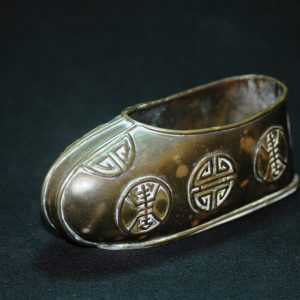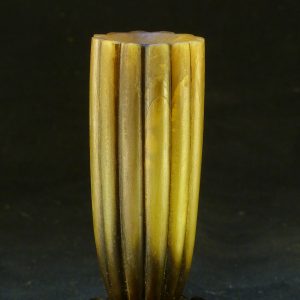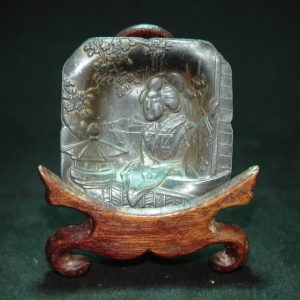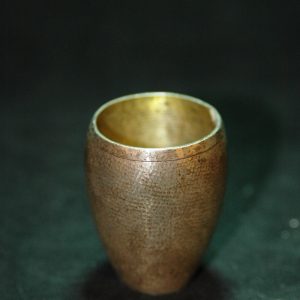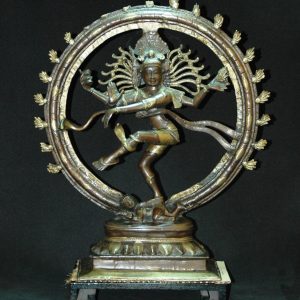Description
鎏金湿婆舞王佛
参考:佳士得 拍賣 16049
印度、喜瑪拉雅及東南亞工藝精品
紐約|2018年3月21日
拍品319|PROPERTY FROM A PRIVATE NEW YORK COLLECTION
印度南部 泰米爾納德邦 毗奢耶那伽羅王朝 十五世紀 濕婆納塔羅闍銅像
SOUTH INDIA, TAMIL NADU, VIJAYANAGARA PERIOD, 15TH CENTURY
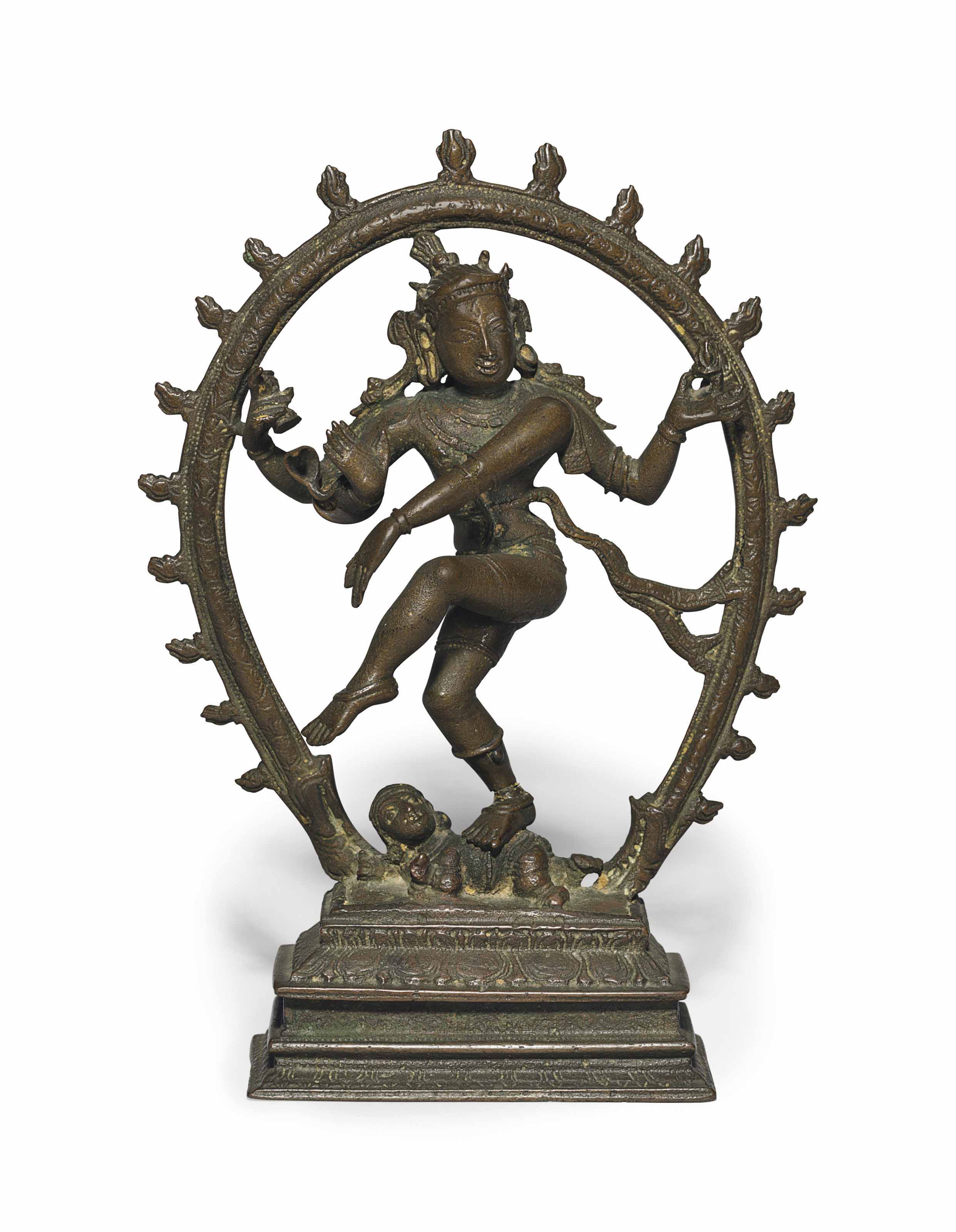
成交總額
USD 11,875
估價
USD 6,000 – USD 8,000
印度南部 泰米爾納德邦 毗奢耶那伽羅王朝 十五世紀 濕婆納塔羅闍銅像
6 ¼ in. (15.9 cm.) high
來源
Private collection, Massachussetts.
Sotheby’s New York, 20 March 1997, lot 279.
拍品專文
Compare with a very similar bronze figure of Shiva Nataraja sold at Christie’s New York, 13 September 2016, lot 248.
参考:纽约大都会博物馆 印度 铜鎏金 湿婆舞王佛 Shiva as Lord of Dance (Shiva Nataraja), Copper alloy, India (Tamil Nadu) late 12th–early 13th century




Object Details
Period:Chola period (880–1279)
Date:late 12th–early 13th century
Culture:India (Tamil Nadu)
Medium:Copper alloy
Dimensions:H. 25 3/4 in. (65.4); W. 22 in. (55.9 cm); D. 7 3/4 in. (19.7 cm)
Classification:Metalwork
Credit Line:Harris Brisbane Dick Fund, 1964
Accession Number:64.251
Provenance
[ John J. Klejman , New York, until 1964, sold to MMA]
Exhibition History
Kansas City. William Rockhill Nelson Gallery of Art. “Master Bronzes of India,” 1965.
New York. Asia House Gallery. “Master Bronzes of India,” October 12, 1965–December 11, 1965.
Barcelona. Casa Àsia. “Divine Presence: Arts of India and the Himalayas,” March 15, 2003–June 22, 2003.
New York. Rubin Museum of Art. “Visions of the Cosmos: From Milky Ocean to Black Hole,” December 11, 2009–May 10, 2010.
Timeline of Art History
Timelines
South Asia: South, 1000-1400 A.D.
参考:鎏金湿婆舞王佛
dancing shiva Nataraja – Brass Statue

Price: CDN$ 793.37
Nataraja
Hand Crafted Brass Statue
Made in India
Technical Details
Item Weight 3.80 kilograms
Is Assembly Required No
Batteries Required No
Additional Information
ASIN B01LZ7F8CG
Shipping Weight 3.8 Kg
参考:Super Large Size Nataraja – Brass Statue

Super Large Size Nataraja – Brass Statue
Price: CDN$ 10,038.00
Nataraja
Hand Crafted Brass Statue
Made in India
Technical Details
Item Weight 156 kilograms
Is Assembly Required No
Batteries Required No
Additional Information
ASIN B01NAS96UQ
Customer Reviews Be the first to review this item
Shipping Weight 156 Kg
Product description
In Sanskrit Nata means dance and raja means Lord.
There is an interesting legend behind the conception of Shiva as Nataraja: In a dense forest in South India, there dwelt multitudes of heretical sages. Thither proceeded Shiva to confute them, accompanied by Vishnu disguised as a beautiful woman. The sages were at first led to violent dispute amongst themselves, but their anger was soon directed against Shiva, and they endeavored to destroy him by means of incantations. A fierce tiger was created in sacrificial fires, and rushed upon him; but smiling gently, he seized it and, with the nail of his little finger, stripped off its skin, and wrapped it about himself like a silken cloth. Undiscouraged by failure, the sages renewed their offerings, and produced a monstrous serpent, which however Shiva seized and wreathed about his neck like a garland. Then he began to dance; but there rushed upon him a last monster in the shape of a malignant dwarf. Upon him the god pressed the tip of his foot, and broke the creature’s back, so that it writhed upon the ground; and so, his last foe prostrate, Shiva resumed the dance.
To understand the concept of Nataraja we have to understand the idea of dance itself. Like yoga, dance induces trance, ecstasy and the experience of the divine. In India consequently, dance has flourished side by side with the terrific austerities of the meditation grove (fasting, absolute introversion etc.). Shiva, therefore, the arch-yogi of the gods, is necessarily also the master of the dance.
Shiva Nataraja was first represented thus in a beautiful series of South Indian bronzes dating from the tenth and twelfth centuries A.D. In these images, Nataraja dances with his right foot supported by a crouching figure and his left foot elegantly raised. A cobra uncoils from his lower right forearm, and the crescent moon and a skull are on his crest. He dances within an arch of flames. This dance is called the Dance of Bliss (anandatandava).
These iconographic details of Nataraja are to be read, according to the Hindu tradition, in terms of a complex pictorial allegory:
The figure depicts a four-armed Shiva. These multiple arms represent the four cardinal directions. Each hand either holds an object or makes a specific mudra (gesture).
The upper right hand holds a hour-glass drum which is a symbol of creation. It is beating the pulse of the universe. The drum also provides the music that accompanies Shiva’s dance. It represents sound as the first element in an unfolding universe, for sound is the first and most pervasive of the elements. The story goes that when Shiva granted the boon of wisdom to the ignorant Panini (the great Sanskrit grammarian), the sound of the drum encapsulated the whole of Sanskrit grammar. The first verse of Panini’s grammar is in fact called Shiva sutra.
The hour-glass drum also represents the male and female vital principles; two triangles penetrate each other to form a hexagon. When they part, the universe also dissolves.
The opposite hand, the upper left, bears on its palm a tongue of flames. Fire is the element of destruction of the world. According to Hindu mythology at the end of the world, it will be fire that will be the instrument of annihilation. Thus in the balance of these two hands is illustrated a counterpoise of creation and destruction. Sound against flames, ceaselessness of production against an insatiate appetite of extermination.
The second right hand is held in the abhaya pose (literally without fear) and so a gesture of protection, as an open palm is most likely to be interpreted. It depicts the god as a protector.
The left leg is raised towards the right leg and reaches across it; the lower left hand is stretched across the body and points to the upraised left foot which represents release from the cycle of birth and death. Interestingly, the hand pointing to the uplifted foot is held in a pose imitative of the outstretched trunk of an elephant. In Sanskrit this is known as the ‘gaja-hasta-mudra (the posture of the elephant trunk), and is symbolic of Ganesha, Shiva’s son, the Remover of obstacles.
Shiva dances on the body of a dwarf apasmara-purusha (the man of forgetfulness) who embodies indifference, ignorance and laziness. Creation, indeed all creative energy is possible only when the weight of inertia (the tamasic darkness of the universe) is overcome and suppressed. The Nataraja image thus addresses each individual to overcome complacency and get his or her own act together.
The ring of fire and light, which circumscribes the entire image, identifies the field of the dance with the entire universe. The lotus pedestal on which the image rests locates this universe in the heart or consciousness of each person.
Another aspect of Nataraja rich in a similar symbolism is his lengthy and sensuous hair. The long tresses of his matted hair, usually piled up in a kind of pyramid, loosen during the triumphant, violent frenzy of his untiring dance. Expanding, they form two wings, to the right and left, a kind of halo, broadcasting, as it were, on their magic waves, the exuberance and sanctity of vegetative, sensuous life.
Supra-normal life-energy, amounting to the power of magic, resides in such a wildness of hair untouched by the scissors. The conceptualization here is similar to the legend of Samson who with naked hands tore asunder the jaws of a lion. His strength was said to reside in his hair.
Also central to understanding the symbolism behind Nataraja’s hair is the realization that much of womanly charm, the sensual appeal of the Eternal Feminine, is in the fragrance, the flow and luster of beautiful hair. On the other hand, anyone renouncing the generative forces of the vegetable-animal realm, revolting against the procreative principle of life, sex, earth, and nature, and entering upon the spiritual path of absolute asceticism, has first to be shaved. He must simulate the sterility of an old man whose hairs have fallen and who no longer constitutes a link in the chain of generation. He must coldly sacrifice the foliage of the head.
Shiva is thus two opposite things: archetypal ascetic and archetypal dancer. On the one hand he is total tranquillity-inward calm absorbed in itself, absorbed in the void of the Absolute, where all distinctions merge and dissolve, and all tensions are at rest. But on the other hand he is total activity- life’s energy, frantic, aimless and playful.
The Nataraja image represents not simply some event in the mythic life of a local deity but a universal view in which the forces of nature and the aspirations and limitation of man confront each other and are blended together. The curator of the Indian collection of the Metropolitan Museum of Art has rightly written that: “If one had to select a single icon to represent the extraordinarily rich and complex cultural heritage of India, the Shiva Nataraja might well be the most remunerative candidate.”

![[临渊阁]天地一家春](https://www.antiquekeeper.ca/wp-content/uploads/2023/04/BW-Erping-1a-17-6-1.jpg)



























